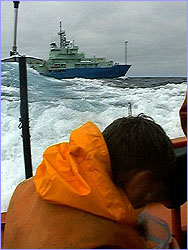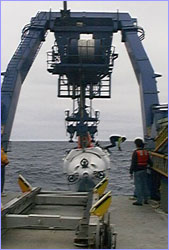
|
 |
 |
by Peter Tyson June 29, 1998 You have to be on your toes around here. I was typing at one of the lashed-down computers in the main lab, lamenting the fact that I wasn't joining the zodiac heading over to visit the nearby research ship Atlantis II, where the submersible Alvin was about to return from a daylong mission, when Susan Lewis, the producer of the NOVA film, came running into the room, yelling my name. "Peter! Aren't you going to the Atlantis?" "No, there wasn't room," I said. "Well, they're up there ready to go, and they're waiting for you." I abandoned the e-mail message I'd been writing in mid-sentence and flew up to 02 level, where five passengers stood beside the orange zodiac, draped head-to-toe in raingear. Turns out the one space offered to a crew member was unfilled, and I was next in line. "You have two minutes to get your camera and a life jacket," Captain Drewry said. I was back in one. In the rush, I neglected to put on my raingear. An unfortunate oversight, as it transpired. As soon as the zodiac was lowered over the side and unceremoniously dropped the final few feet into the roiling sea, the roiling sea started coming over the side and into my lap. The winds were 15 to 20 knots, the seas four or five feet, and we were heading straight into both of them. Every time I chanced a glance forward to catch a glimpse of the Atlantis, a cold slap of seawater greeted me in the face. It took 20 minutes to cover the mile and a half to the Atlantis, a blue ship against a gray sky. By then I was wetter than a drowned rat, but I was too caught up in it all to worry about it. A rope ladder was tossed over the lee rail, and soon we were climbing it. You held onto the ladder with one hand and, when a wave lifted the zodiac to its highest point, you put a foot on the highest step you could reach, to ensure that the next time the zodiac came up, about three seconds later, it didn't squish your foot against the hull. Soon we were aboard. Dr. Alan Chave, chief scientist on the Atlantis, kindly took us under his wing. First he led us into a lab room, where Sherry White, one of his graduate students at the Woods Hole Oceanographic Institution, told us how her team was studying the mysterious light that emanates from black smoker chimneys. On a computer screen, she called up some photos taken the day before by Alvin, which had to sit still, turn off all its lights, and open the shutter for a full five minutes to get the exposure. The screen showed nine separate images in nine different wavelength bands; the longer the wavelength, the brighter the light. "We think the light is thermal radiation," White said. Chave's team is now trying to figure out if any microbes or other creatures live off this eerie illumination. Then we were off to the Alvin control room, up several flights of stairs.There Steve Faluotico, one of the Alvin pilots, was monitoring the progress of Alvin more than 7,000 feet below the ship. We could hear the ping of the transponders on the seafloor, and whenever the Alvin pilot spoke from far below, his voice echoed through the deep sea as if inside a vast auditorium. "You're clear to surface," Faluotico said into the mike. Soon the sub had dropped its weights—500 pounds of them—and began rising at about 100 feet a minute. At such depth, it would take them an hour and a half to reach the surface.
Then we were on deck, watching a zodiac race out to meet Alvin, which had surfaced the mandatory 1,650 to 3,300 feet from the Atlantis and was now bobbing about in the waves. As a diver climbed onto the sub, the ship carefully pulled near. The retrieval of the sub is a tricky procedure, and, like kids on a schoolbus, we were told to stay behind a yellow line painted on the deck. As the ship drew close, a second diver who had climbed up to join the first fastened a leg-thick line to the top of Alvin. When the sub was about ten feet in the air it began swinging, and the divers quickly dove off (see photo). Just as quickly the deck crew had it under control, and soon Alvin was safely stowed on board. Two of three people on board, including Chave's wife, were first-time divers and thus, upon stepping out of the sub, got the requisite dousing with a bucket of ice water. Minutes later the Thompson's zodiac returned to pick us up. This time someone handed me a yellow rainjacket and pants. I put them on, but it hardly mattered. Like those Alvin first-timers, I was soaked and lovin' it. Peter Tyson is Online Producer of NOVA. The Tug of the Thompson (June 23) The ROPOS Guys (June 25) In the Juan de Fuca Strait (June 27) Special Report: A Visit To Atlantis (June 29) Dive 440 (July 1) Rescue at Sea (July 2) What's Your Position? (July 4) Phang! (July 5) 20,000 Pounds of Tension (July 8) Four for Four (July 11) Thrown Overboard (July 13) Was Grandma a Hyperthermophile? (July 15) Swing of the Yo-Yo (July 18) The Mission | Life in the Abyss | The Last Frontier | Dispatches E-mail | Resources | Table of Contents | Abyss Home Editor's Picks | Previous Sites | Join Us/E-mail | TV/Web Schedule About NOVA | Teachers | Site Map | Shop | Jobs | Search | To print PBS Online | NOVA Online | WGBH © | Updated October 2000 |
 En route to the Atlantis
En route to the Atlantis
 The Alvin returns to the Atlantis.
The Alvin returns to the Atlantis.